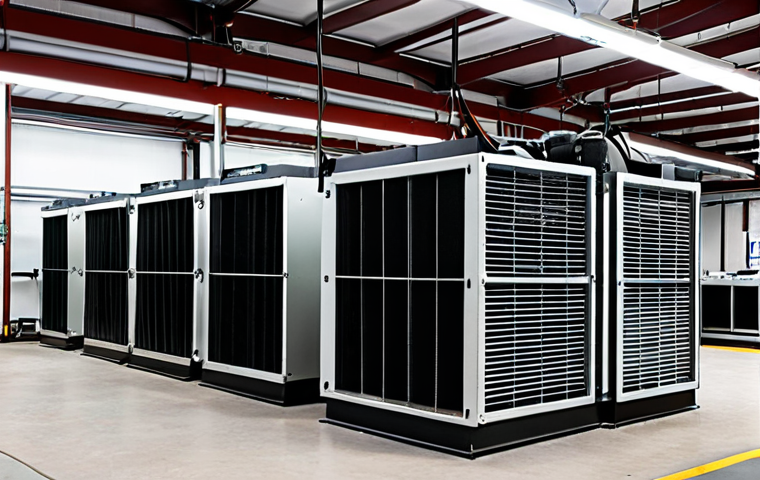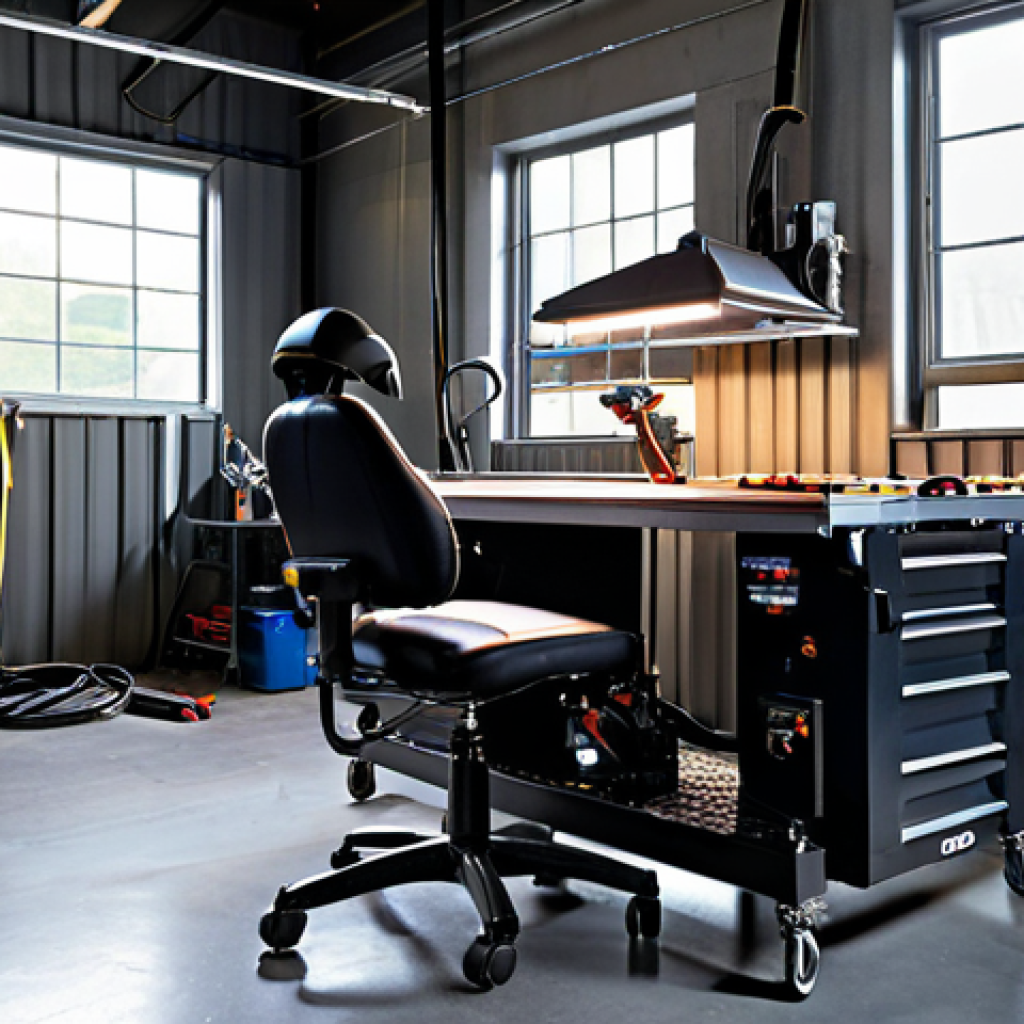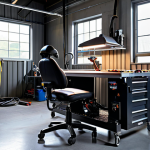Welding is a skilled trade, but let’s face it, the work environment can often be less than ideal. I’ve personally seen welders struggle with poor ventilation, inadequate lighting, and uncomfortable workstations, all of which take a toll on their health and productivity.
With the rise of advanced welding techniques and the increasing demand for high-quality welds, it’s crucial to address these workplace challenges head-on.
Moreover, innovations like exoskeletons and augmented reality are beginning to reshape the welding landscape, promising to enhance both safety and efficiency.
The industry is also seeing a push for more sustainable practices, focusing on reducing fumes and waste. Let’s delve into some practical and innovative ideas for creating a better welding environment, for welders now, and for the future of the welding industry.
Let’s explore this further in the following article.
Ergonomic Workstations: A Foundation for Welder Well-being

Proper ergonomics are absolutely essential in a welding environment. After spending hours hunched over a welding table, I can tell you firsthand that back pain and muscle fatigue are no joke.
Investing in adjustable welding tables and chairs can make a world of difference. I’m talking about tables that can be raised or lowered to suit the welder’s height, and chairs with proper lumbar support.
Customizable Welding Tables
Adjustable welding tables aren’t just a luxury; they’re a necessity. A good table should allow the welder to work comfortably whether standing or sitting.
Look for tables with features like tilt adjustment, which can be especially useful for welding at different angles. I remember one shop I worked in had these tables, and the difference in comfort and productivity was significant.
We weren’t nearly as tired at the end of the day. It’s not just about comfort. A proper welding table allows the welder to position the workpiece precisely, ensuring accurate and high-quality welds.
Features like built-in clamps and grounding points can further streamline the welding process, saving time and reducing the risk of errors. Ergonomic design also minimizes strain on the welder’s body, reducing the risk of musculoskeletal disorders like carpal tunnel syndrome.
Investing in adjustable tables demonstrates a commitment to worker well-being, which can boost morale and reduce employee turnover.
Supportive Seating Solutions
Welding chairs or stools need to be just as carefully considered as the tables. A good chair should offer adjustable height, back support, and a comfortable seat cushion.
Features like footrests and armrests can also enhance comfort and reduce strain on the welder’s body. I’ve sat on some pretty awful stools in my time, and believe me, you feel it after a few hours.
A supportive chair can prevent back pain, improve posture, and reduce fatigue. When selecting a welding chair, ensure it is made from durable materials that can withstand the harsh conditions of a welding environment.
Look for features like heat resistance and easy-to-clean surfaces. The chair should also be stable and provide a secure base to prevent accidents. Consider models with wheels for easy mobility around the workstation, allowing the welder to move freely without having to get up and down constantly.
Advanced Ventilation Systems: Breathing Easy in the Workshop
Welding fumes are a serious health hazard, and adequate ventilation is non-negotiable. I’ve worked in shops where the ventilation was so poor that you could barely see across the room.
It’s not just unpleasant; it’s downright dangerous. Investing in a high-quality ventilation system is one of the best things you can do for your welders.
Source Capture Systems
These systems are designed to capture fumes at the source, before they have a chance to disperse into the air. Portable fume extractors are a great option for smaller shops or for welders who move around frequently.
These units typically have a flexible arm that can be positioned close to the welding arc, capturing fumes as they are produced. Centralized ventilation systems, on the other hand, are better suited for larger shops with multiple welding stations.
These systems typically consist of a network of ducts and hoods that exhaust fumes to the outside. Both types of systems should be equipped with high-efficiency particulate air (HEPA) filters to remove harmful particles from the air.
Regular maintenance and filter replacement are essential to ensure the system operates effectively.
Air Filtration and Purification
Even with source capture systems in place, some fumes may still escape into the air. Air filtration and purification systems can help to remove these remaining contaminants.
Air purifiers with activated carbon filters can remove odors and gases, while HEPA filters can capture fine particles. These systems are particularly important in enclosed spaces where natural ventilation is limited.
Consider installing multiple air purifiers throughout the shop to ensure comprehensive coverage. Regular filter replacement is crucial to maintain the effectiveness of these systems.
Air filtration and purification systems not only protect welders from harmful fumes but also improve the overall air quality of the workplace, creating a more pleasant and healthier environment for everyone.
Optimizing Lighting: Illuminating the Path to Precision
Adequate lighting is crucial for precision welding. Trying to weld in a dimly lit environment is not only difficult but also increases the risk of errors and accidents.
I’ve squinted my way through far too many welds in poorly lit shops, and it’s not an experience I’d recommend to anyone.
Task-Specific Lighting Solutions
Overhead lighting is a good start, but it’s not enough. Task-specific lighting, such as adjustable lamps or spotlights, is essential for illuminating the welding area.
These lights should be positioned to minimize shadows and glare. LED lighting is a great option because it’s energy-efficient and provides bright, consistent illumination.
I’ve found that having a light that I can adjust to exactly where I need it makes a huge difference in the quality of my work. Make sure the lighting is adjustable so that welders can adapt it to their specific needs and preferences.
The color temperature of the light is also important; a neutral or cool white light is generally preferred for welding because it provides better contrast and reduces eye strain.
Regular maintenance and bulb replacement are essential to ensure optimal lighting conditions.
Glare Reduction Strategies
Glare can be a major problem in welding environments, especially when working with reflective materials. Anti-glare coatings on safety glasses and welding helmets can help to reduce glare and improve visibility.
Properly positioning lighting fixtures to avoid direct reflections can also make a big difference. I remember one shop I worked in had installed these anti-glare screens around the welding stations, and it was a game-changer.
We were able to see so much better, and our eyes didn’t feel nearly as tired at the end of the day. Consider using diffuse lighting options, such as indirect lighting or lamps with diffusers, to spread light more evenly and reduce glare.
Regular cleaning of lighting fixtures is also important to maintain their effectiveness and prevent dust buildup that can scatter light and create glare.
Noise Reduction Strategies: Creating a Quieter Workspace
Welding can be a noisy business, and prolonged exposure to high noise levels can lead to hearing loss. Providing welders with hearing protection is essential, but there are also other steps you can take to reduce noise levels in the workplace.
Acoustic Barriers and Soundproofing
Acoustic barriers can be used to isolate noisy equipment or processes, such as grinders or plasma cutters. These barriers are typically made of sound-absorbing materials that can reduce the transmission of noise.
Soundproofing materials can also be applied to walls and ceilings to further reduce noise levels. I’ve seen some shops install these soundproof booths around the welding stations, and it really made a difference.
You could still hear the welding going on, but it wasn’t nearly as loud or disruptive. When selecting acoustic barriers and soundproofing materials, ensure they are fire-resistant and comply with safety regulations.
Regular maintenance and inspection are essential to ensure these measures continue to be effective.
Equipment Maintenance and Dampening Techniques
Regular maintenance of welding equipment can help to reduce noise levels. Worn or loose parts can vibrate and create excessive noise. Dampening techniques, such as applying vibration-damping materials to equipment, can also help to reduce noise.
I remember one time, our welding machine was making this horrible rattling noise, and it turned out that a bolt had come loose. Once we tightened it, the noise went away.
It’s amazing how much noise a small problem can create. Ensure that all equipment is properly lubricated and adjusted to minimize noise. Consider using quieter welding processes, such as pulsed welding, which can reduce noise levels compared to conventional welding techniques.
Investing in Advanced Safety Gear: Beyond the Basics
While standard safety gear like helmets and gloves are essential, investing in advanced safety gear can provide welders with an extra layer of protection and comfort.
Powered Air-Purifying Respirators (PAPRs)
PAPRs provide welders with clean, filtered air, protecting them from harmful fumes and particles. These respirators typically consist of a helmet with a built-in fan that draws air through a filter and delivers it to the welder’s breathing zone.
I’ve used PAPRs in some particularly nasty welding environments, and they really make a difference. You can breathe easy knowing that you’re not inhaling all those fumes.
Make sure the PAPR is properly fitted and maintained to ensure its effectiveness. Regular filter replacement is essential to maintain optimal airflow and filtration.
Exoskeletons for Welders
Exoskeletons are wearable devices that can help to reduce strain on the welder’s body. These devices provide support to the back, shoulders, and arms, allowing welders to work longer and more comfortably.
I’ve seen some exoskeletons in action, and they’re pretty impressive. They can really help to reduce fatigue and prevent injuries. Consider exoskeletons for welders who perform repetitive tasks or work in awkward positions.
Ensure the exoskeleton is properly fitted and adjusted to the welder’s body. Regular maintenance and inspection are essential to ensure the device operates safely and effectively.
| Improvement Area | Solutions | Benefits |
|---|---|---|
| Ergonomics | Adjustable welding tables, supportive seating | Reduced back pain, improved posture, increased comfort |
| Ventilation | Source capture systems, air filtration | Reduced exposure to harmful fumes, improved air quality |
| Lighting | Task-specific lighting, glare reduction | Improved visibility, reduced eye strain, fewer errors |
| Noise Reduction | Acoustic barriers, equipment maintenance | Reduced noise levels, prevention of hearing loss |
| Safety Gear | PAPRs, exoskeletons | Enhanced protection, reduced fatigue, injury prevention |
Promoting Sustainable Welding Practices: A Greener Approach
Welding can have a significant environmental impact, but there are steps you can take to reduce your footprint.
Reducing Waste and Emissions
Switching to more efficient welding processes, such as pulsed welding or laser welding, can help to reduce energy consumption and emissions. Properly maintaining welding equipment can also help to reduce waste.
I’ve seen some shops implement recycling programs for welding consumables, such as electrodes and shielding gas cylinders. It’s a small thing, but it adds up.
Consider using renewable energy sources to power your welding operations. Ensure that all welding waste is disposed of properly and in accordance with environmental regulations.
Using Eco-Friendly Materials
When possible, choose welding materials that are made from recycled content or that have a lower environmental impact. Some manufacturers offer eco-friendly welding electrodes and shielding gases.
I’ve also seen some shops using bio-based lubricants for their welding equipment. It’s all about making small changes that can add up to a big difference.
Research and choose materials that have been certified as environmentally friendly. Consider using water-based cleaning solutions instead of harsh chemicals.
The Role of Augmented Reality (AR) in Training and Safety
Augmented reality is revolutionizing the welding industry, offering innovative solutions for training, safety, and quality control.
AR-Enhanced Training Modules
AR can provide welders with realistic simulations of welding processes, allowing them to practice their skills in a safe and controlled environment. These simulations can also provide real-time feedback on welding technique, helping welders to improve their skills more quickly.
I’ve seen some AR welding training programs in action, and they’re really impressive. They can provide a much more immersive and engaging learning experience than traditional training methods.
Consider implementing AR training modules for both new and experienced welders. Ensure the AR system is properly calibrated and maintained to provide accurate simulations.
Real-Time Safety Overlays
AR can also be used to provide welders with real-time safety information, such as warnings about potential hazards or reminders about proper safety procedures.
This information can be displayed directly in the welder’s field of vision, helping them to stay safe while working. I’ve seen some AR welding helmets that can display information about the welding parameters, such as voltage and amperage.
This can help welders to monitor their work more closely and prevent errors. Develop AR applications that provide welders with relevant safety information in a clear and concise manner.
Ensure the AR system is compatible with the welder’s existing safety gear. Ergonomic workstations aren’t just a trend; they’re an investment in your welders’ health, productivity, and the overall quality of your work.
By prioritizing ergonomics, ventilation, lighting, noise reduction, advanced safety gear, and sustainable practices, you can create a welding environment that is not only safe and efficient but also enjoyable for your team.
Remember, a happy welder is a productive welder, and a safe workspace is a successful workspace.
In Conclusion
Creating a safe and efficient welding environment is a multifaceted endeavor. It requires a commitment to not only providing the right equipment but also fostering a culture of safety and continuous improvement. Prioritizing these elements will undoubtedly lead to a healthier, happier, and more productive welding team.
Investing in your welders’ well-being is an investment in the long-term success of your business. By creating a supportive and ergonomic work environment, you can attract and retain top talent, reduce absenteeism, and boost overall productivity.
Remember, a comfortable and healthy welder is a productive welder. By focusing on ergonomics, safety, and sustainability, you can create a welding environment that is both efficient and enjoyable.
Good to Know
1. OSHA Regulations: Familiarize yourself with OSHA’s welding-specific safety regulations to ensure compliance and avoid potential fines. Check out the OSHA website for resources.
2. NIOSH Recommendations: The National Institute for Occupational Safety and Health (NIOSH) offers recommendations for controlling welding hazards, including ventilation and respiratory protection. Visit the NIOSH website for more information.
3. AWS Standards: The American Welding Society (AWS) provides standards and guidelines for welding safety and quality. Consider becoming a member for access to these resources.
4. Local Safety Programs: Many communities offer free or low-cost safety training programs for welders. Contact your local community college or technical school for more information.
5. Ergonomic Assessments: Consult with an ergonomics specialist to conduct a workplace assessment and identify potential hazards. They can provide customized recommendations for improving ergonomics in your welding environment.
Key Takeaways
Ergonomics First: Invest in adjustable workstations and seating to prevent musculoskeletal disorders.
Ventilation is Vital: Implement source capture systems and air filtration to protect welders from harmful fumes.
Optimize Lighting: Use task-specific lighting and glare reduction strategies to improve visibility and reduce eye strain.
Reduce Noise: Utilize acoustic barriers and equipment maintenance to minimize noise levels and prevent hearing loss.
Advanced Safety Gear: Provide PAPRs and exoskeletons for enhanced protection and reduced fatigue.
Frequently Asked Questions (FAQ) 📖
Q: What are some immediate steps welding shops can take to improve the working environment for their welders?
A: Based on what I’ve seen working around fabrication shops in Detroit, a good starting point is upgrading the ventilation system. I mean, you’ve gotta get those fumes outta there!
Also, investing in adjustable workstations can make a huge difference. I’ve seen welders hunched over their work for hours, and it’s no wonder they complain about back pain.
Even something as simple as providing proper lighting can significantly reduce eye strain and improve the quality of their welds. Think of it like tuning up your car – regular maintenance and upgrades keep things running smoothly and the driver happy.
Q: Beyond the basics, what innovative technologies are making a real impact on the welding industry right now?
A: Honestly, the coolest thing I’ve seen lately is the introduction of exoskeletons. I saw a demo at a trade show in Chicago, and it was mind-blowing. These things support your arms and back, letting you handle heavy materials without killing yourself.
I’ve also heard about augmented reality welding helmets that project instructions and data right onto the visor. Imagine being able to see exactly where to weld and what settings to use – it’s like having a personal welding coach!
These advancements aren’t just about making the job easier; they’re about improving precision and reducing errors, too.
Q: How can welding companies become more sustainable and environmentally conscious in their practices?
A: This is a big one, and I think it starts with responsible material usage. I’ve visited some shops that have been using every scrap, every off-cut, that they have, and it feels nice to be using every last bit.
Also, many companies are using welding equipment that is more energy efficient, like inverter-based machines, which use less power and reduce waste. Another focus should be on fume reduction.
Investing in fume extraction systems and using welding consumables that produce fewer emissions are both smart moves. It’s also important to properly dispose of waste materials, recycling whenever possible.
Think about it: a greener welding shop is not only good for the planet, but it’s also good for the company’s image and its employees’ health.
📚 References
Wikipedia Encyclopedia
구글 검색 결과
구글 검색 결과
구글 검색 결과
구글 검색 결과
구글 검색 결과


